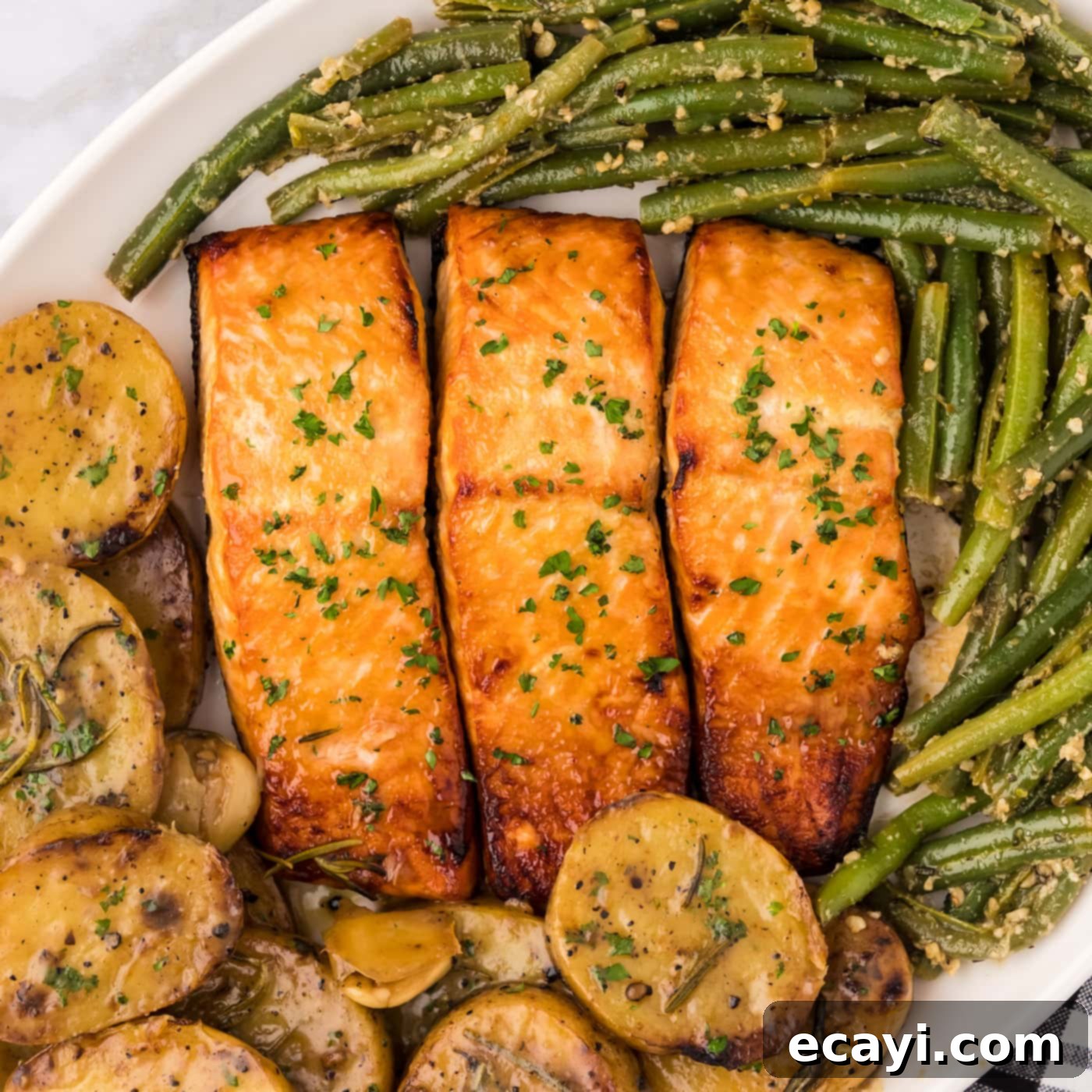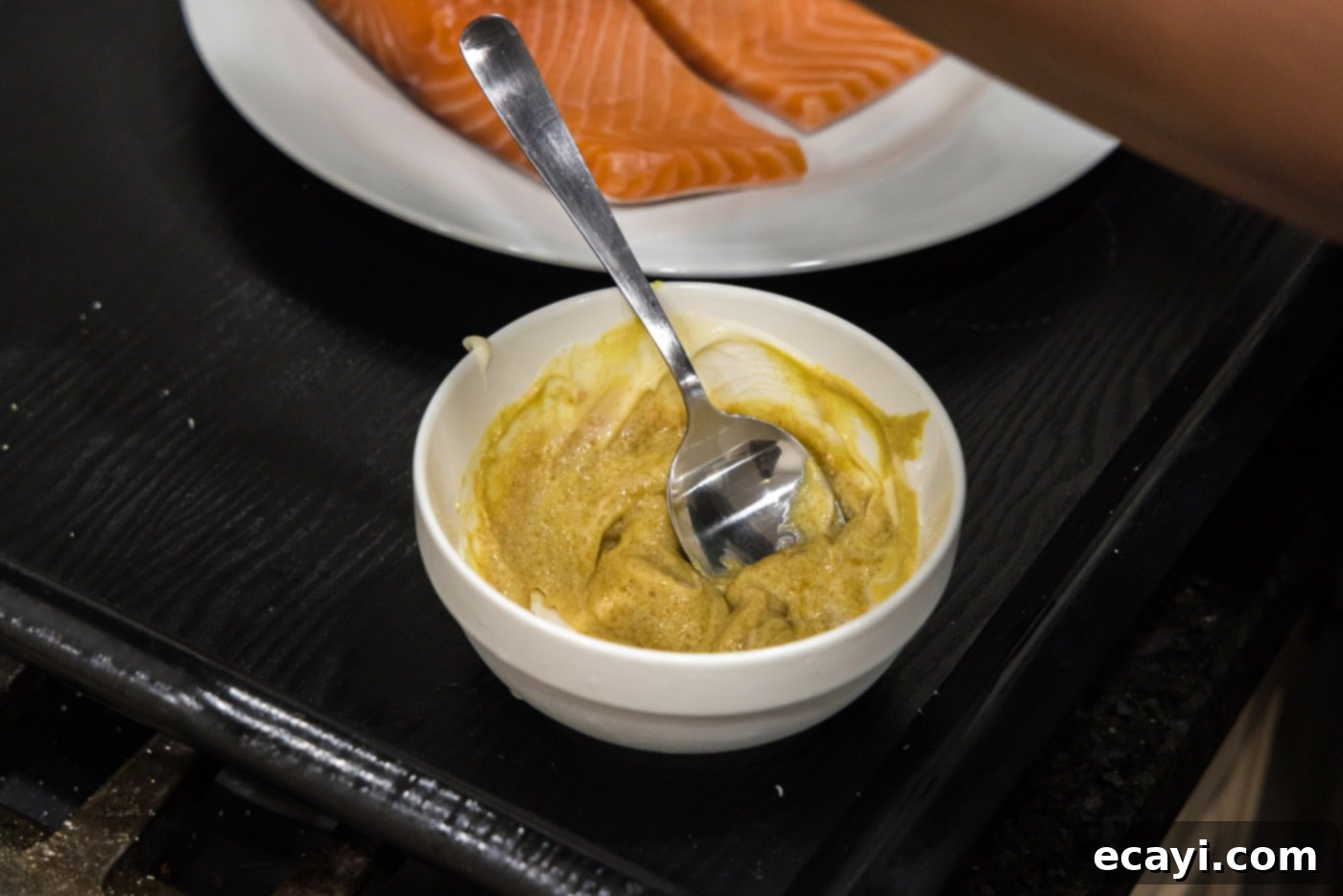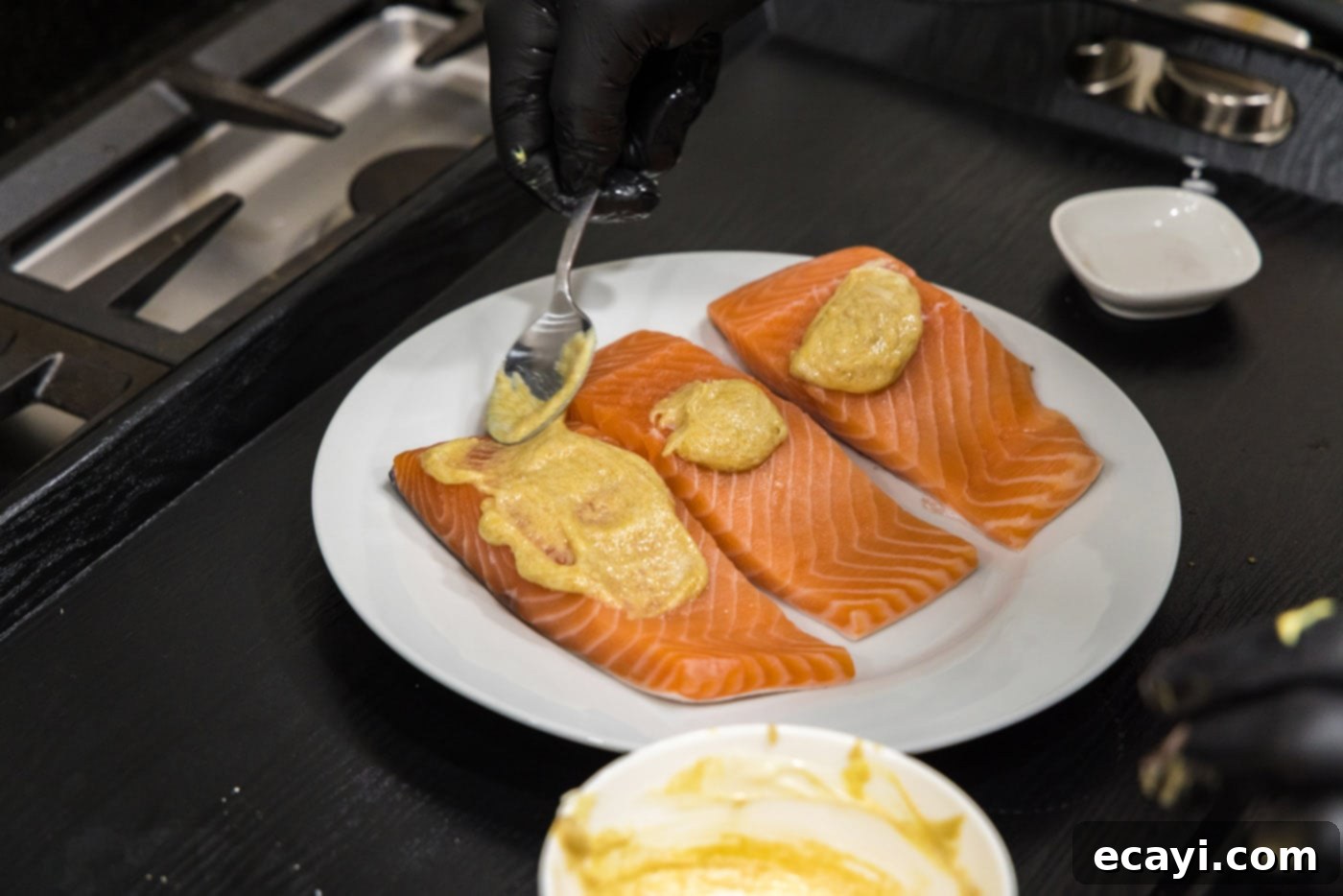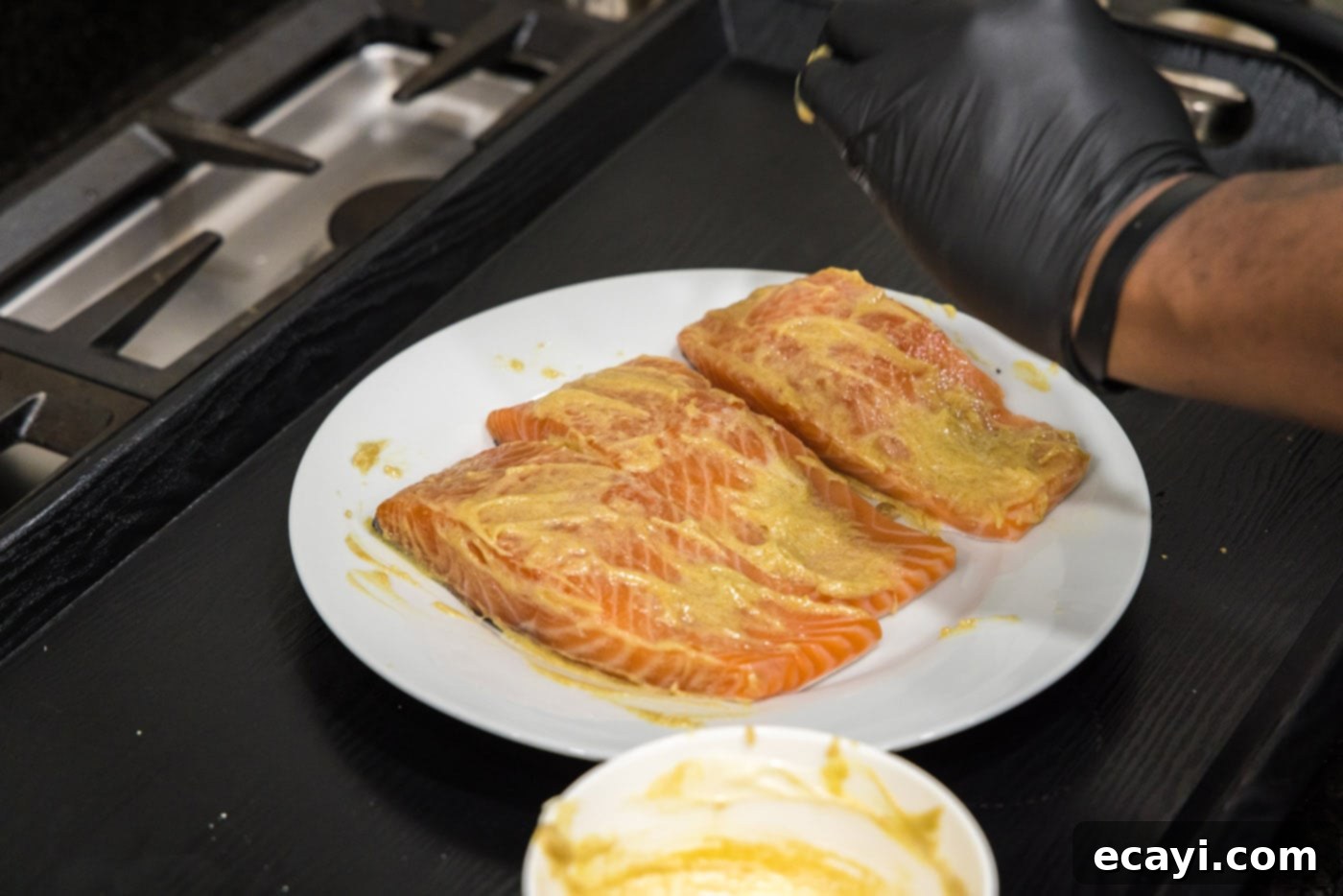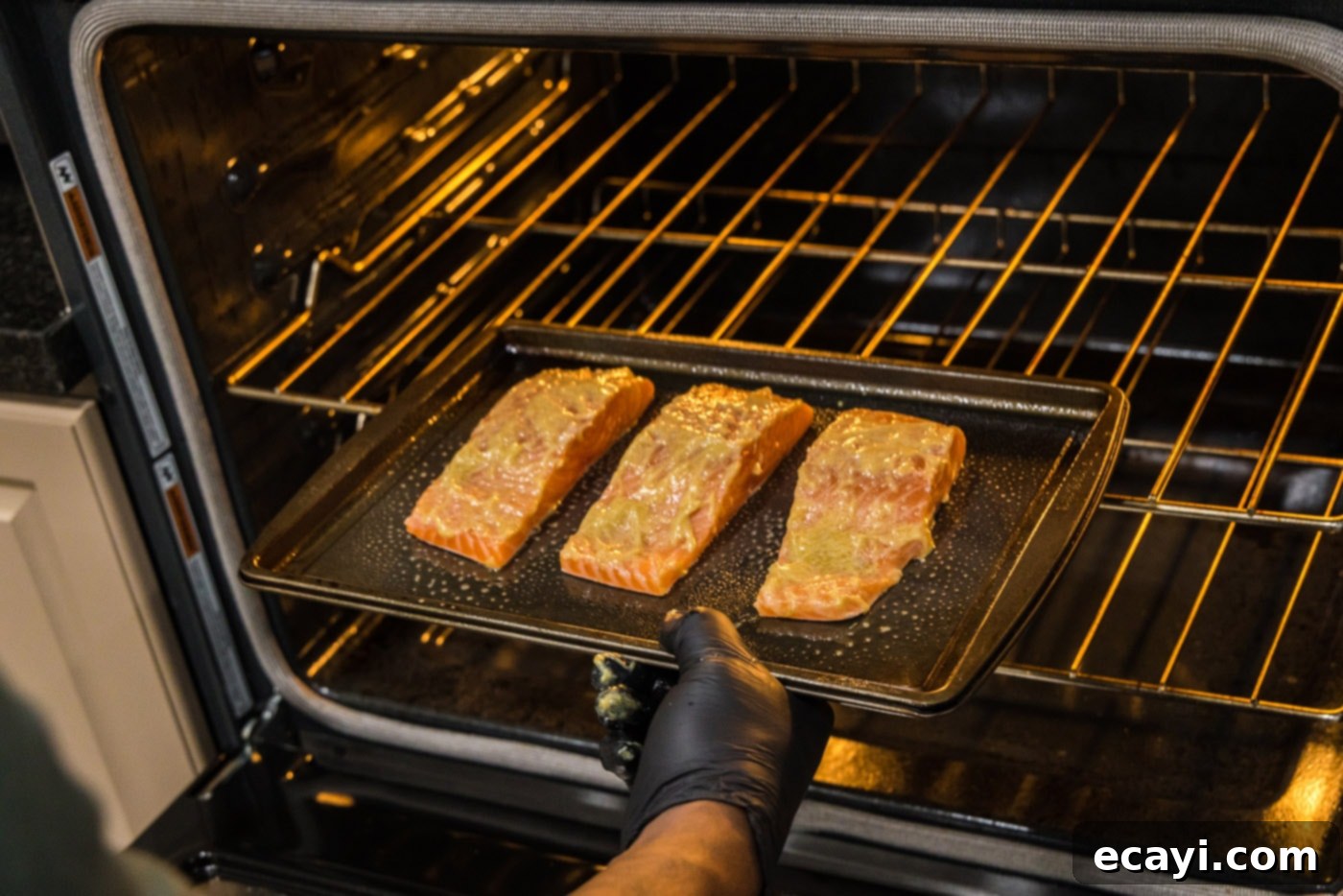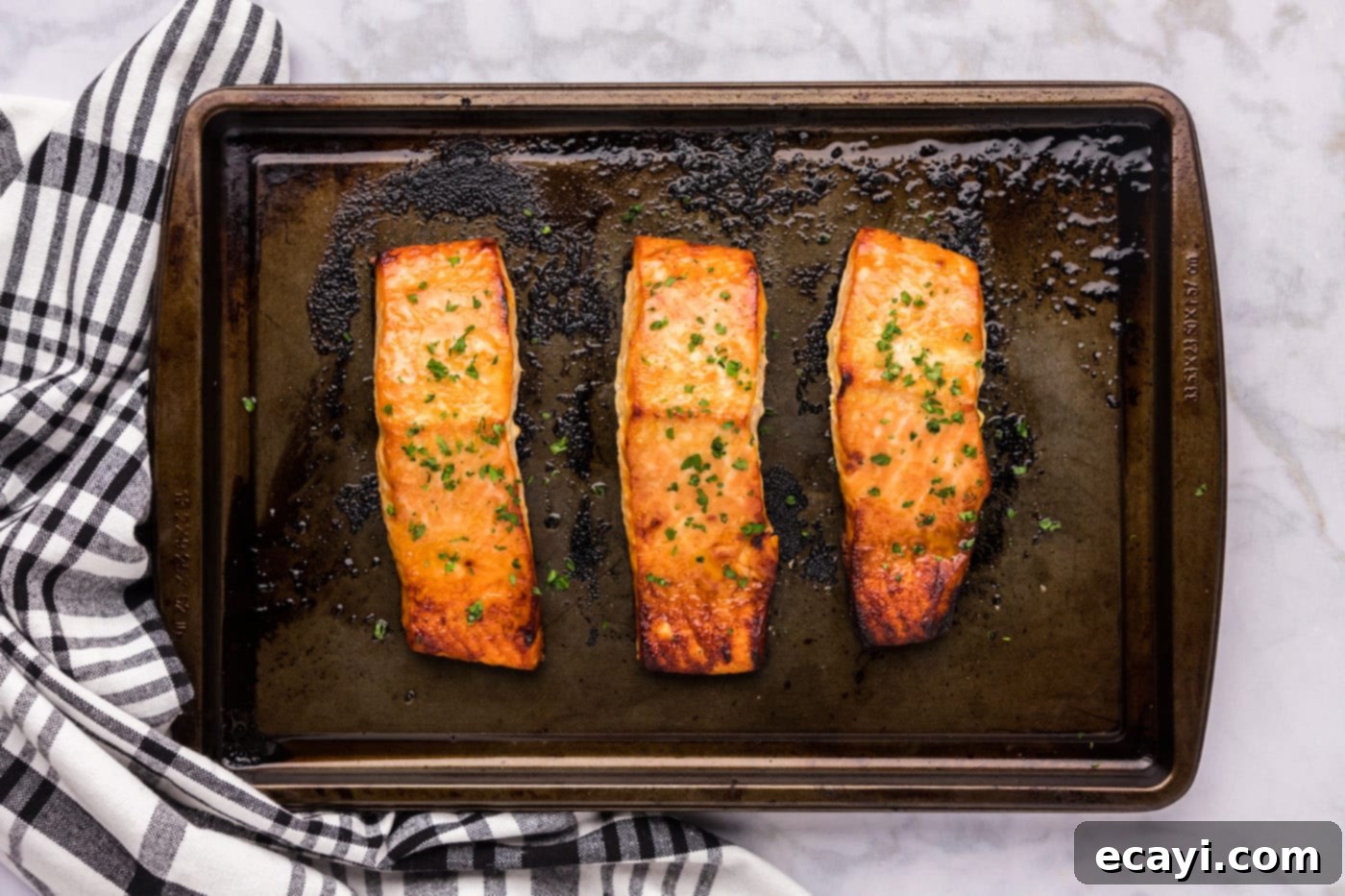Easy Brown Sugar Salmon Recipe: Sweet, Savory, and Ready in Minutes!
Prepare to delight your taste buds with this incredibly simple yet profoundly delicious brown sugar salmon recipe. Featuring a mouthwatering glaze crafted from just four essential ingredients – Dijon mustard and brown sugar – this dish promises a sticky, sweet, and savory caramelization that will leave you craving more. It’s an effortlessly elegant meal, perfect for any night of the week, transforming flaky salmon into an unforgettable culinary experience.
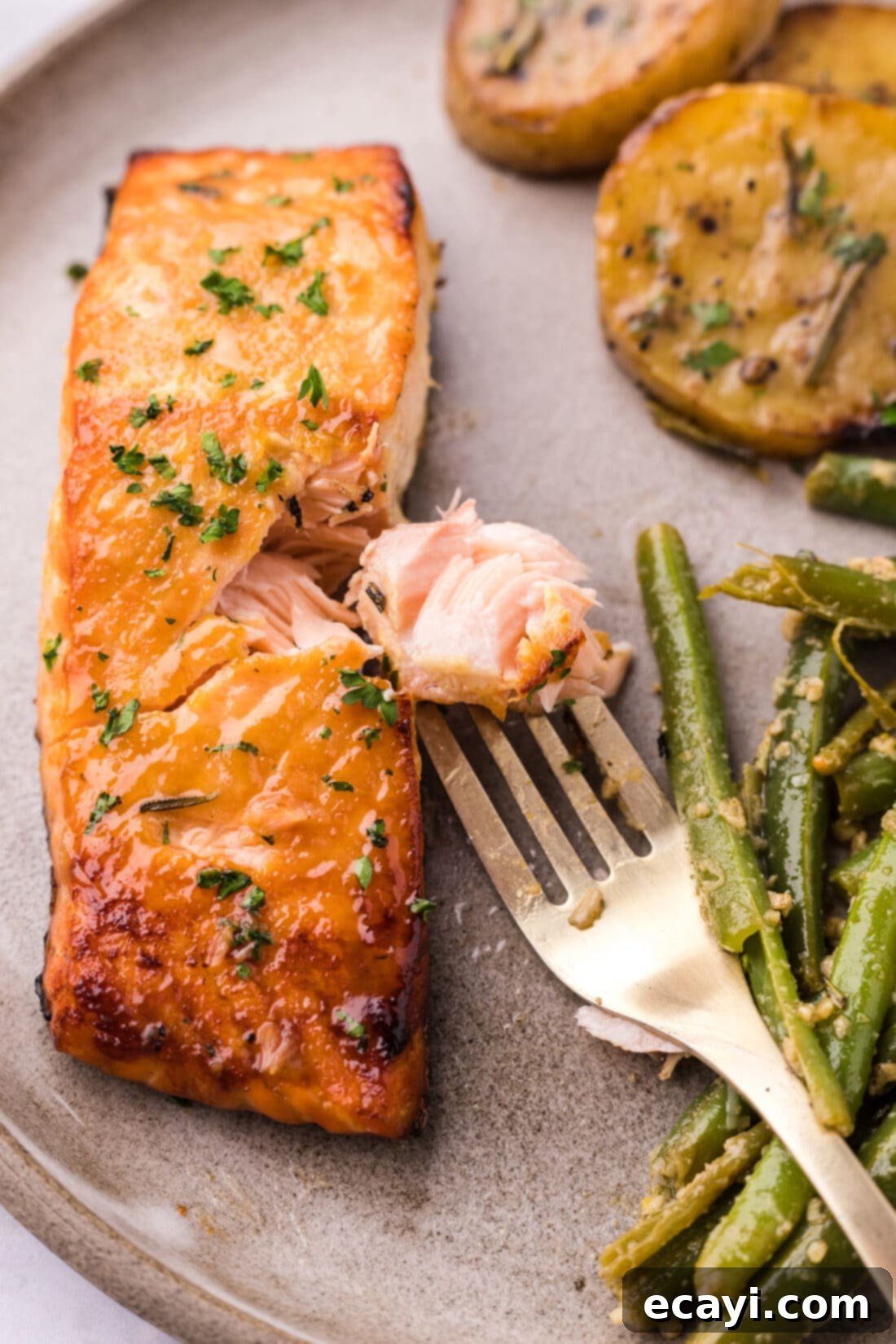
Why This Brown Sugar Salmon Recipe Is a Must-Try
Salmon is truly a magnificent canvas for a myriad of flavors, and this brown sugar rendition is no exception. Its naturally rich, buttery texture and mild taste make it incredibly versatile, capable of absorbing and enhancing diverse seasonings – from the zesty notes of dill salmon to the bold kick of Cajun salmon. Our love for this nutritious fish knows no bounds, and for good reason! Salmon is a powerhouse of essential nutrients, generously packed with beneficial omega-3 fatty acids, vital B vitamins (including B12), and quality protein, all while being remarkably low in saturated fats.
This particular brown sugar salmon recipe elevates the humble filet into something extraordinary. The combination of tangy Dijon mustard and sweet brown sugar creates a magical glaze that caramelizes beautifully in the oven, forming a delectable crust. This crust doesn’t just add an explosion of flavor; it also locks in moisture, ensuring each bite of salmon is incredibly tender, juicy, and flakey. The contrasting sweet and savory notes make for a perfectly balanced dish that feels gourmet but is surprisingly simple to prepare. It’s a guaranteed crowd-pleaser that adds a gorgeous, irresistible flair to your dinner table, making it an absolute winner in our culinary lineup.
Beyond its incredible taste, this recipe shines for its convenience. Requiring minimal ingredients and prep time, it’s the ideal solution for busy weeknights when you want a healthy, delicious meal without the fuss. The straightforward baking method means less hands-on time, allowing you to focus on other tasks or simply relax while your oven does the work. In just about 35 minutes, you can have a restaurant-quality meal on the table that’s both nourishing and deeply satisfying.
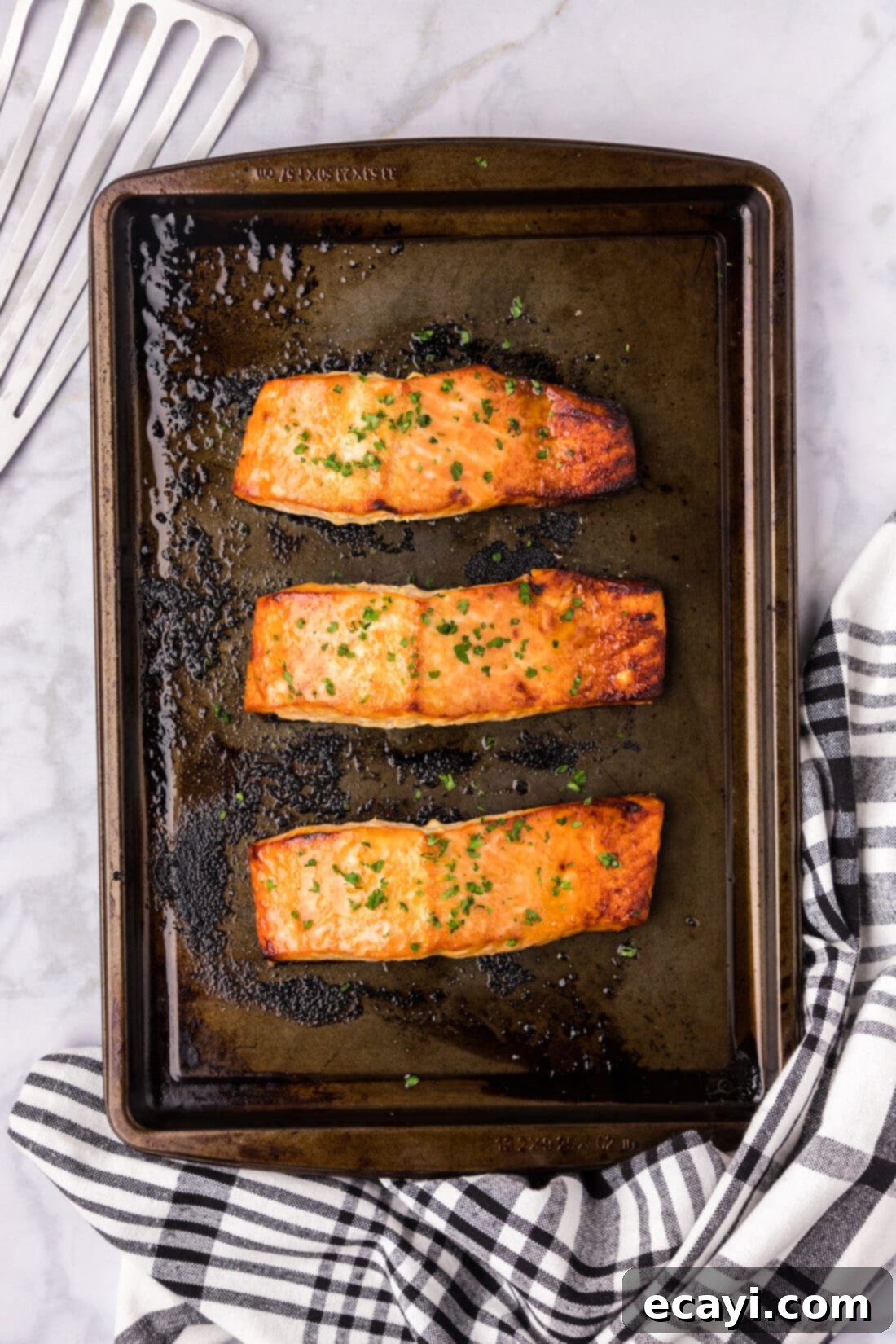
Simple Ingredients for Irresistible Flavor
One of the true beauties of this brown sugar salmon recipe lies in its simplicity. You only need a handful of common ingredients to create an incredibly flavorful meal. For precise measurements and a complete list, please refer to the printable recipe card located at the end of this post. Gather your ingredients, and let’s get cooking!
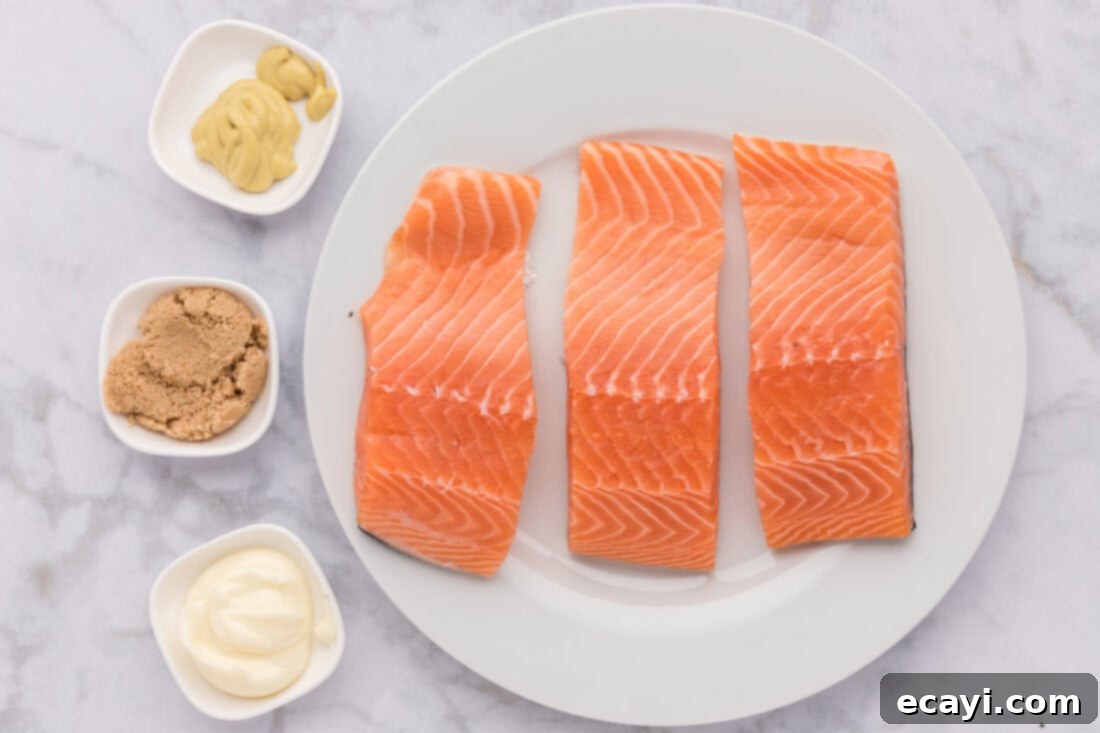
Ingredient Spotlight & Expert Tips
Let’s dive a little deeper into the ingredients and offer some helpful tips for achieving the best results with your brown sugar salmon.
SALMON – For optimal results, we highly recommend using high-quality, fresh center-cut salmon. Center-cut fillets offer a more uniform thickness, which ensures even cooking and prevents thinner ends from drying out while the thicker parts cook. If you’re working with a large fillet, use a sharp chef’s knife to slice it into individual 3-4 ounce portions, typically three per pound. While fresh is ideal, if you must use frozen salmon, ensure it is completely thawed overnight in the refrigerator before preparation. Cooking partially frozen fish can lead to uneven textures and can extend cooking times. Always cook your salmon with the skin side down. The skin acts as a protective layer, preventing the delicate flesh from sticking to the pan and helping it retain moisture. Placing it skin side up can cause the fish to flake prematurely, making it difficult to transfer without falling apart.
BROWN SUGAR – This is the star of our sweet and savory glaze! Light brown sugar is typically used for its molasses content, which contributes to the delightful caramelization and rich depth of flavor. If you only have dark brown sugar on hand, you can certainly use it; it will result in an even deeper, more robust molasses flavor. The key is to ensure it’s packed firmly when measuring to get the right balance of sweetness. The brown sugar not only adds sweetness but also helps create that beautiful, sticky crust as it bakes.
DIJON MUSTARD – Dijon mustard is crucial for providing that wonderful tangy counterbalance to the sweetness of the brown sugar. Its slightly sharp, pungent, and subtly spicy notes prevent the glaze from being overly sweet, creating a complex and addictive flavor profile. We recommend classic smooth Dijon for this recipe. If you don’t have Dijon, a good quality honey mustard could work for a sweeter profile, or even a stone-ground mustard for added texture, though the flavor will be slightly different. Avoid plain yellow mustard, as its flavor is too mild and vinegary for this application.
BUTTER – Softened butter is essential for achieving a smooth, spreadable glaze. It acts as a binder for the brown sugar and Dijon, helping them meld together and adhere to the salmon fillets. We suggest using unsalted butter so you can control the overall sodium content of the dish, adding salt to taste. If you only have salted butter, simply omit any additional salt until you’ve tasted the prepared glaze. Make sure your butter is truly “very soft, like pudding” as mentioned in the recipe card, which will make mixing effortless and ensure even coating.
OPTIONAL SEASONING – While the core four ingredients provide incredible flavor, a pinch of salt and freshly ground black pepper can enhance the overall taste. Add a sprinkle to your salmon fillets before applying the glaze, or season after baking if desired.
Effortless Steps to Perfect Brown Sugar Salmon
These step-by-step photos and instructions are here to help you visualize how to make this recipe successfully. For a comprehensive, printable version of this recipe, complete with exact measurements and detailed instructions, you can Jump to Recipe at the bottom of this post.
- Prepare Your Oven: Begin by preheating your oven to a consistent 400°F (200°C). This ensures that when the salmon goes in, it starts cooking immediately and develops that beautiful caramelized crust.
- Craft the Irresistible Glaze: In a small bowl, combine the brown sugar, tangy Dijon mustard, and very soft butter. Stir these ingredients together vigorously until they are thoroughly incorporated and form a smooth, consistent mixture. The consistency should be easy to spread, akin to a thick paste.

- Generously Glaze the Salmon: Take your perfectly prepared salmon fillets and generously spread the mustard-brown sugar mixture over the flesh of each one. Ensure an even coating, pushing the glaze right to the edges. This thick layer is what will caramelize and create that delectable, sticky crust.


- Bake to Perfection: Carefully place your glazed salmon fillets, skin side down, onto a baking sheet. Bake them in the preheated oven for approximately 25 minutes. The cooking time may vary slightly depending on the thickness of your salmon, so keep an eye on it. The goal is perfectly cooked, flakey salmon with a beautifully caramelized, bubbly glaze.
EXPERT TIP – For an easier cleanup, you can line your baking sheet with parchment paper. This creates a non-stick surface and prevents the sugary glaze from adhering to the pan. We generally advise against using aluminum foil for this recipe, as the caramelized sugar can sometimes stick to foil, making it difficult to remove the fish cleanly. However, if foil is your only option, be sure to spray it thoroughly with a non-stick cooking spray before placing the salmon.


Frequently Asked Questions & Expert Tips for Brown Sugar Salmon
Determining when salmon is perfectly cooked is key to avoiding dry, overcooked fish. The most reliable method is to use an instant-read meat thermometer inserted into the thickest part of the fillet; salmon is done when it reaches an internal temperature of 145°F (63°C). Visually, you can also test for doneness by gently pressing your finger (or the tip of a knife if it’s too hot) onto the top center or thickest part of the salmon. If the flesh begins to flake easily or separate along its natural lines, it is cooked through. The center should still appear slightly translucent, not entirely opaque. Be cautious not to overcook, as this will result in a dry, overly flaky texture that diminishes the salmon’s natural richness.
Proper storage is crucial for maintaining the quality and safety of leftover salmon. Allow the salmon to cool completely to room temperature (this usually takes about 15-20 minutes). Once cooled, transfer the leftovers to an air-tight container. This prevents air exposure, which can dry out the fish and lead to spoilage. Store the container in the refrigerator for 2-3 days. While salmon is best enjoyed fresh, these storage methods will ensure you can savor it later.
To reheat leftover brown sugar salmon without drying it out, the oven is your best friend. Preheat your oven to a low temperature, around 275°F (135°C). Place the salmon fillets on a foil-lined baking sheet (lightly greased if desired) to help retain moisture. Reheat for about 10-15 minutes, or until the salmon is warmed through. Avoid high heat or prolonged reheating, which can make the fish tough and dry. The microwave can be used in a pinch on a lower power setting, but it often yields less desirable results in terms of texture.
Absolutely! The brown sugar and Dijon glaze can be prepared in advance to make meal prep even quicker. Simply mix the brown sugar, Dijon mustard, and softened butter in a small bowl, cover it, and store it in the refrigerator for up to 3-4 days. When you’re ready to cook, let the glaze come to room temperature for about 15-20 minutes to soften, making it easier to spread evenly over the salmon fillets. This can save valuable time on busy cooking days.
Certainly! This recipe is wonderfully versatile. If you enjoy a little heat, a pinch of red pepper flakes or a dash of cayenne pepper can be mixed into the glaze. For a hint of garlic, you can add 1/2 teaspoon of garlic powder. A squeeze of fresh lemon juice over the cooked salmon can also brighten the flavors beautifully. Feel free to experiment with a sprinkle of smoked paprika for an extra layer of savory depth.
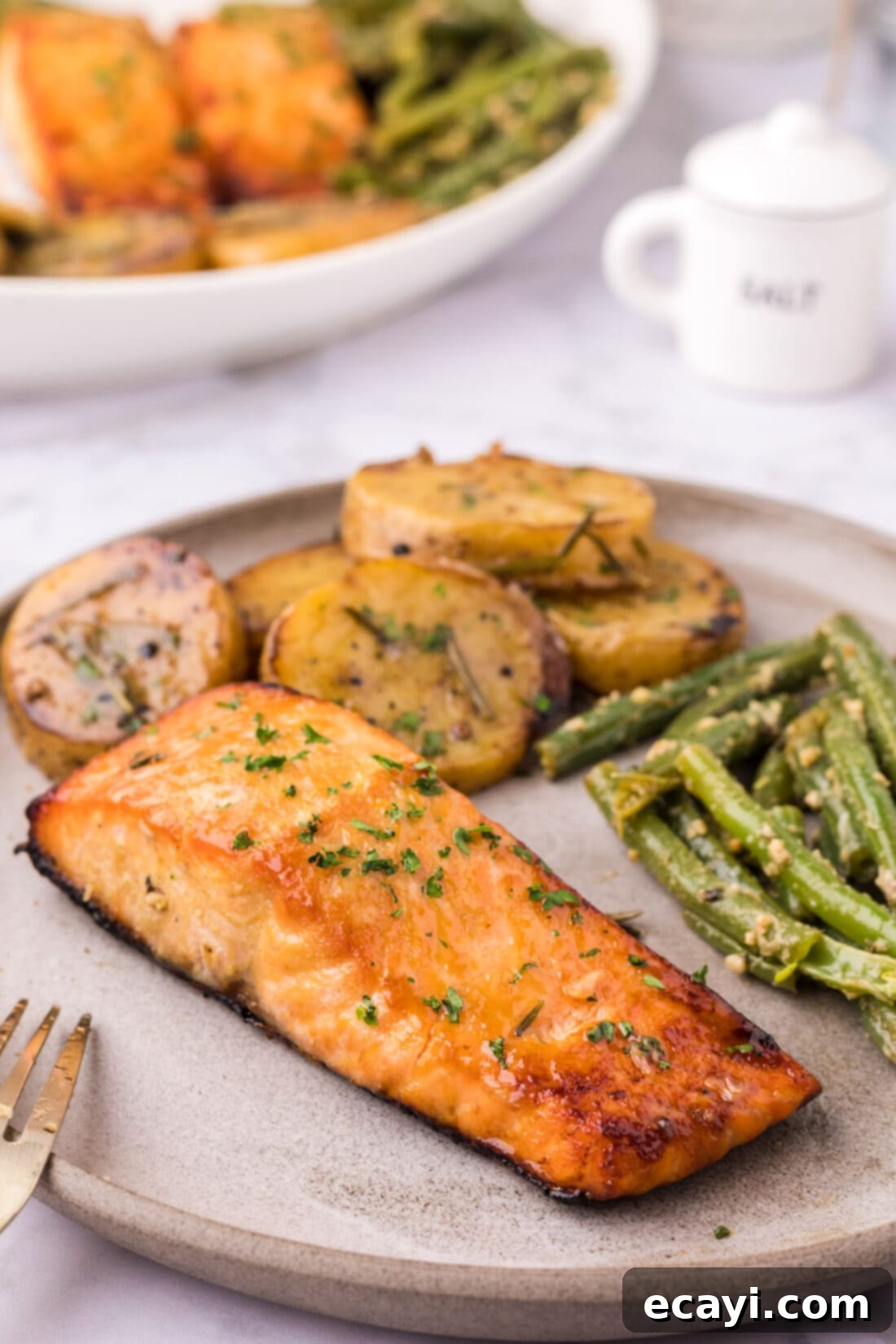
Delicious Serving Suggestions for Brown Sugar Salmon
This brown sugar salmon is incredibly flavorful on its own, but pairing it with the right side dishes can elevate your meal into a truly complete and satisfying experience. The sweet and savory profile of the salmon makes it versatile enough to complement a wide range of accompaniments. Here are some fantastic serving suggestions:
- Rice: A simple bed of fluffy white rice, brown rice, or quinoa is perfect for soaking up any extra glaze and provides a comforting base.
- Potatoes: Whether you prefer light and airy mashed potatoes, crispy garlic roasted potatoes, or rich Parmesan potatoes, potatoes are always a winning side. Our “melting potatoes” (as seen in the image) are another excellent choice, offering a creamy interior and crispy exterior.
- Green Vegetables: Balance the richness of the salmon with fresh, vibrant green vegetables. Steamed or roasted asparagus, tender broccoli florets, or our delicious garlic green beans are all superb options that add color and nutrients to your plate.
- Fresh Salad: For a lighter meal, a crisp, tossed dinner salad with a light vinaigrette provides a refreshing contrast to the sweet salmon.
- Roasted Root Vegetables: Roasted carrots, parsnips, or sweet potatoes can complement the brown sugar glaze beautifully, enhancing the sweet and earthy notes of the dish.
- Creamy Polenta or Risotto: For a more indulgent side, a creamy polenta or a light risotto can provide a luxurious texture and absorb the glaze wonderfully.
To add a dash of heat and an extra layer of flavor, consider sprinkling some red pepper flakes over the salmon just before serving. Enjoy this delightful brown sugar salmon warm, straight from the oven, for the best taste and texture. It’s truly a versatile dish that can be dressed up or down depending on your occasion and preference.
Discover More Irresistible Salmon Recipes
If you love the versatility and flavor of salmon as much as we do, you’re in for a treat! We have a treasure trove of incredible salmon recipes to explore, each offering a unique twist on this beloved fish. From vibrant and zesty to bold and savory, there’s a salmon dish for every craving and occasion. Expand your culinary repertoire with these other fantastic options:
- Bright & Zesty Lemon Salmon
- Sweet & Savory Teriyaki Salmon
- Bold & Spicy Blackened Salmon
- Rich & Umami Maple Soy Salmon
- Classic Dijon Lemon Caper Salmon
Each of these recipes brings out different facets of salmon’s flavor, ensuring that you’ll never run out of delicious ways to enjoy this healthy and versatile fish.
I love to bake and cook and share my kitchen experience with all of you! Remembering to come back each day can be tough, that’s why I offer a convenient newsletter every time a new recipe posts. Simply subscribe and start receiving your free daily recipes!
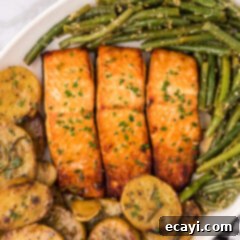
Brown Sugar Salmon
IMPORTANT – There are often Frequently Asked Questions within the blog post that you may find helpful. Simply scroll back up to read them!
Print It
Pin It
Rate It
Save ItSaved!
Ingredients
- 2 ½ Tablespoons brown sugar
- 1 Tablespoon Dijon mustard
- 2 ½ Tablespoons butter should be very soft, like pudding
- 1 pound center cut salmon cut into 3 filets
Things You’ll Need
-
Baking sheet
-
Vinyl gloves
Before You Begin
- Center cut salmon provides uniform thickness between your filets. Use a sharp chef’s knife to slice the filet into 3 smaller filets. We highly recommend using fresh salmon over frozen. If you do have frozen salmon, allow it to fully thaw overnight in the refrigerator before using. Always cook fish with the skin side down. If you place the fish skin side up, the fish will cook and begin to flake, making it fall apart as you lift it.
- To test for doneness, gently press your finger (or the tip of a knife if it’s too hot) onto the top center or thickest part of the salmon – if it begins to flake or separate then it is done cooking. If you overcook the salmon, it will be dry and overly flaky.
- Store leftovers in an air-tight container kept in the refrigerator for 2-3 days. Reheat in the oven set to 275F on a foil-lined baking sheet for 10 minutes or until warmed through.
Instructions
-
Preheat oven to 400 F.
-
Combine brown sugar, dijon mustard, and butter in a small bowl. Stir together until incorporated.
-
Spread mustard mixture over the flesh of each salmon filet.
-
Place filets on baking sheet and bake for 25 minutes.
TIP – You can line your baking sheet with parchment paper if you want less clean up. However, we don’t recommend foil as the sugary coating drips off and may make the skin of the fish stick. If you use foil, be sure to spray it with non-stick cooking spray.
Nutrition
The recipes on this blog are tested with a conventional gas oven and gas stovetop. It’s important to note that some ovens, especially as they age, can cook and bake inconsistently. Using an inexpensive oven thermometer can assure you that your oven is truly heating to the proper temperature. If you use a toaster oven or countertop oven, please keep in mind that they may not distribute heat the same as a conventional full sized oven and you may need to adjust your cooking/baking times. In the case of recipes made with a pressure cooker, air fryer, slow cooker, or other appliance, a link to the appliances we use is listed within each respective recipe. For baking recipes where measurements are given by weight, please note that results may not be the same if cups are used instead, and we can’t guarantee success with that method.
